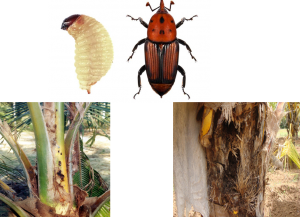
Red Palm Weevil (RPW) Rhynchophorus ferrugineus is a serious pest attacking different species of palm trees like Coconut, Oil palm. The larvae are the most destructive stage of the weevil as they penetrate deep in the lower part of the stem causing a lot of damage to the internal tissues. When the infestation is severe, the whole tree falls and dies.
Symptoms of damage
- The hole can be seen on the stem with chewed up fibres protruding out.
- Many times reddish-brown liquid can be seen oozing out from the hole.
- The grubs cause damage inside the stem or crown by feeding on soft tissues and often cause severe damage especially when a large number of them bore into the soft, growing parts. In case of severe infestation, the inside portion of the trunk is completely eaten and becomes full of rotting fibres.
- In the case of young palms the top withers while in older palms the top portion of the trunk bends and ultimately breaks at the bend (wilting).
- Sometimes the gnawing sound produced by the feeding grubs inside will also be audible.
- In the advanced stage of infestation yellowing of the inner whorl of leaves occur. The crowns fall down or dry up later when the palm is dead.
Management practices
Cultural Method
- Remove and burn all wilting or damaged palms in coconut gardens to prevent the further perpetuation of the pest.
- Avoid the cutting of green leaves. If needed, they should be cut about 120 cm away from the stem in order to prevent successful inward movement of the grubs through the cut end.
Chemical Method
- In attacked palms, observe for the boreholes and seal them except the topmost one. Through the topmost holes, pour 1% carbaryl (20gm/lt) or 0.2% trichlorfon @ one litre per palm using a funnel. Then plug this hole also. If needed repeat after one week.
- When the pest infestation is through the crown, clean the crown and slowly pour the insecticidal suspension. In case of entry of weevil through the trunk, the hole in the trunk may be plugged with cement/tar. A slanting hole is made with the aid of an auger and the insecticide solution is poured with a funnel.
- Fill the crown and the axils of the topmost three leaves with a mixture of fine sand and neem seed powder or neem seed kernel powder (2:1) once in three months to prevent the attack of rhinoceros beetle damage in which the red palm weevil lays eggs.
Pheromone Trap
- Install pheromone trap @ one trap per acre
- Step 1: Specialized buckets with 3 of 4 holes are made, the bucket is wound with coconut fibre/ jute sack so that the pests can enter.
- Step 2: The lure (Ferrolure +) is suspended inside the bucket and one lit of water is added along with 100g pineapple/ sugarcane, 2g yeast, and 2g Carbaryl in the bucket.
- Step 3: The bait buckets are placed at sites on the farm, where the infestation is seen most.
- Step 4: After a week the water is checked for the catch & refilled to prevent mosquitoes from breeding.
Source:
1. CPCRI
2. TNAU – official website
3. Google






